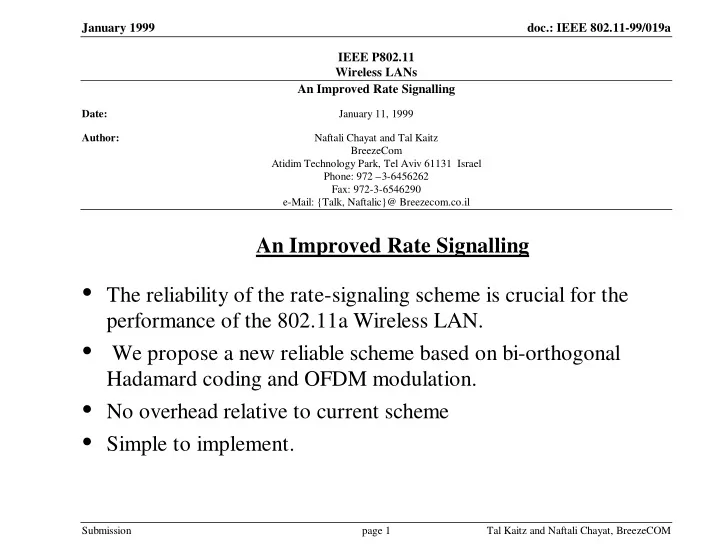

January 1999 doc.: IEEE 802.11-99/019a IEEE P802.11 Wireless LANs An Improved Rate Signalling Date: January 11, 1999 Author: Naftali Chayat and Tal Kaitz BreezeCom Atidim Technology Park, Tel Aviv 61131 Israel Phone: 972 –3-6456262 Fax: 972-3-6546290 e-Mail: {Talk, Naftalic}@ Breezecom.co.il An Improved Rate Signalling • The reliability of the rate-signaling scheme is crucial for the performance of the 802.11a Wireless LAN. • We propose a new reliable scheme based on bi-orthogonal Hadamard coding and OFDM modulation. • No overhead relative to current scheme • Simple to implement. Submission page 1 Tal Kaitz and Naftali Chayat, BreezeCOM
January 1999 doc.: IEEE 802.11-99/019a Overview of current scheme 5.6 µ s +8.0 µ s +2.4 µ s +1.6 µ s =17.6 µ s 2*0.8 µ s = 1.6 µ s 7*0.8 µ s = 5.6 µ s 1.6 µ s +2*3.2 µ s = 8.0 µ s 0.8 µ s 0.8 µ s +3.2 µ s = 4.0 µ s 4.0 µ s t1 t2 t3 t4 t5 t6 t7 GI T1 T2 Data 1 t8 t9 t10 S1 S2 Data 2 GI GI t1 t1 Signal Detect, Channel and Fine Frequency Offset Estimation SIGNAL DATA Coarse Frequency AGC, Offset Est., diversity sel. Timing Sync • 4 bits are conveyed by QPSK modulating the sequences S1 and S2. • t10 serves as a guard interval. • Overall length 0.8uS+0.8uS+0.8uS=2.4uS. • In AWGN: same error rate as rate ½ BPSK OFDM. (6Mb/s). • Non satisfactory performance under severe multipath conditions. Submission page 2 Tal Kaitz and Naftali Chayat, BreezeCOM
January 1999 doc.: IEEE 802.11-99/019a Proposed Scheme 5.6 µ s +8.0 µ s +2.4 µ s +1.6 µ s =17.6 µ s 2*0.8 µ s = 1.6 µ s 7*0.8 µ s = 5.6 µ s 1.6 µ s +2*3.2 µ s = 8.0 µ s 0.8 µ s 0.8 µ s +3.2 µ s = 4.0 µ s 4.0 µ s t1 t2 t3 t4 t5 t6 t7 t8 t9 GI T1 T2 GI Data 1 Data 2 S1 GI GI t1 t1 t1 Signal Detect, Channel and Fine Frequency Offset Estimation SIGNAL DATA Coarse Frequency AGC, Offset Est., diversity sel. Timing Sync • 4 bits are conveyed by the sequence S1 spanning 1.6uS. • Additional guard interval of 0.8uS. • Overall length 2.4uS – same as before. Submission page 3 Tal Kaitz and Naftali Chayat, BreezeCOM
January 1999 doc.: IEEE 802.11-99/019a Coding and Modulation • 3 LSB select one row of Hadamard 8 matrix. • The MSB selects sign. • The 8 binary symbols are repeated 3 times to form 24 vector. • The vector is multiplied with a cover sequence. • The result is used to modulate the even subcarriers of a 64 point OFDM symbol. The time domain vector has two identical halves. • The time domain vector is cyclically extended and a window is applied to truncate it to length 2.4uS. Submission page 4 Tal Kaitz and Naftali Chayat, BreezeCOM
January 1999 doc.: IEEE 802.11-99/019a Decoding and Demodulation • The 32 samples signal is cyclically extended to provide 64 samples. • A 64-point FFT is used to demodulate. • The even subcarriers are multiplied by the cover sequence. • The subcarriers are combined to produce an 8-point vector. • A Fast Hadamard Transform is applied. • The location of peak determines 3 MSBs. The sign of the peak determines the MSB. • Both modulation and demodulation require existing H/W: namely the 64 point FFT/IFFT • Coding and decoding require an 8 point fast Hadamard transform. Submission page 5 Tal Kaitz and Naftali Chayat, BreezeCOM
January 1999 doc.: IEEE 802.11-99/019a Performance in flat AWGN • Let E s denote the power per spectral line. • Then for rate ½ k=7 BPSK we have d 2 free =10*4E s =40E s . • For bi-orthogonal coding we have d 2 free =2*8*3*E s =48E s . � The bi-orthogonal scheme is better by 0.8dB than the coding scheme of the data section. Submission page 6 Tal Kaitz and Naftali Chayat, BreezeCOM
January 1999 doc.: IEEE 802.11-99/019a Performance in severe multipath Simulation results: 64bytes packets, 6Mb/s. Green : errors in rate field. Blue: errors in data . Rate error and data errors. Trms = 200 nSec Rate error and data errors. Trms = 600 nSec 0 0 10 10 Error rate Error rate -1 -1 10 10 -2 -2 10 10 5 6 7 8 9 10 11 12 13 5 6 7 8 9 10 11 12 13 14 15 EbNo [dB] EbNo [dB] Submission page 7 Tal Kaitz and Naftali Chayat, BreezeCOM
January 1999 doc.: IEEE 802.11-99/019a Peak to Average Power Ratio The cover sequence assures good PAP ratios for all codewords. Codeword PAP [dB] 1 3.2 dB 2 3.7 dB 3 4.6 dB 4 3.7 dB 5 3.2 dB 6 4.2 dB 7 4.6 dB 8 3.7 dB PAP = 3.2dB… 4.6dB. Submission page 8 Tal Kaitz and Naftali Chayat, BreezeCOM
January 1999 doc.: IEEE 802.11-99/019a Extension to 5 bits • Due to the proliferation of codes and data rates, (1/3 , 9/16 etc.) there is a need to convey more then 4 bits. • The proposed scheme can be easily extended to support 5 bits. • Performed by QPSK modulating the H 8 row. • Decoding by complex 8-point FHT. • Same minimum free distance of 48*E s . Double number of minimum distance neighbours => Slight degradation in performance. Submission page 9 Tal Kaitz and Naftali Chayat, BreezeCOM
January 1999 doc.: IEEE 802.11-99/019a Conclusions • A reliable method for transmitting the 4 bits of the rate field. • Requires no overhead relative to the current scheme. • Much lower error rate than the data section even in the most reliable mode, both under flat channel and under severe multipath conditions. • Simple to implement. Uses existing modulation and demodulation mechanisms. • Requires Fast Hadamard Transform to be implemented. Simple extension to 5 bits. Submission page 10 Tal Kaitz and Naftali Chayat, BreezeCOM
Recommend
More recommend